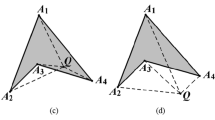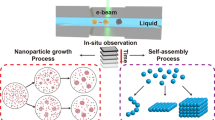Abstract
Using the modified Poisson–Boltzmann (PB) theory, which includes restrictions on the maximum attainable concentration of ionic species in a solution Cmax determined by their effective sizes, the distributions of electrostatic potential φ(r) and ion concentration near a spherical nanoparticle with radius a immersed in a 1 : 1 electrolyte solution have been studied under the conditions of constant surface charge density σs. For weakly charged particles, the φ(r) profiles are almost independent of Cmax and coincide with the profile obtained in terms of the classical PB model. Surface potential |φs| gradually increases with a rise in |σs|. Far from the particle, when the potential becomes lower than its thermal value \({{\varphi }_{{\text{T}}}} = \frac{{kT}}{e}\) (k is the Boltzmann constant, T is the temperature, and e is the elementary charge), the potential decreases exponentially irrespective of the counterion sizes: \(\psi \left( r \right) = \frac{{\varphi \left( r \right)}}{{{{\varphi }_{{\text{T}}}}}} = {{\psi }_{{{\text{eff}}}}}\frac{a}{r}\exp \left( { - \kappa \left( {r - a} \right)} \right),\) where r is the distance from the particle center and κ is the reciprocal Debye radius. According to the classical PB theory, the growth of the surface charge leads to the saturation of \(\left| {{{\psi }_{{{\text{eff}}}}}} \right|~\left( { \to 4} \right),\) with the value of \(\left| {{{\psi }_{{\text{s}}}}} \right|\) obtained by solving the nonlinear PB equation being higher than \(\left| {{{\psi }_{{{\text{eff}}}}}} \right|.\) In the modified PB theory, which takes into account the size of electrolyte ions in the simplest form, this effect of saturation is absent. Now, \(\left| {{{\psi }_{{{\text{eff}}}}}} \right|\) depends on both the value of the surface charge and the sizes of counterions. Moreover, at a large size of counterions, \(\left| {{{\psi }_{{{\text{eff}}}}}} \right|\) substantially exceeds the corresponding value obtained by solving the nonlinear modified PB equation. The difference between the electrical double layer properties obtained by solving the classical and modified PB equations directly follows from the fact that the modified theory predicts the appearance of a condensed layer at a particle surface, with the concentration of counterions in this layer being equal to Cmax. Therewith, the thickness of the layer grows with increasing |σs| (at a constant size of the ions) and the size of the ions (at constant σs).





Similar content being viewed by others
REFERENCES
Verwey, E.J.W. and Overbeek, J.Th.G., Theory of the Stability of Lyophobic Colloids, New York: Elsevier, 1948.
Delahay, P., Double Layer and Electrode Kinetics, New York: Wiley, 1965.
Derjaguin, B.V., Churaev, N.V., and Muller, V.M., Poverkhnostnye sily (Surface Forces), New York: Consultants Bureau, 1987.
Andelman, D., in Handbook of Biological Physics, Lipowsky, R. and Sackmann, E., Eds., Amsterdam: Elsevier Science, 1995, vol. 1, Chap. 12.
Levin, Y., Rep. Prog. Phys., 2002, vol. 65, p. 1577.
Lyklema, J., Fundamentals of Interface and Colloid Science, Amsterdam: Elsevier Academic, 2005.
Ohshima, H., in Nanolayer Research: Methodology and Technology for Green Chemistry, Amsterdam: Elsevier, 2017, Chap. 2.
Gisler, T., Schulz, S.F., Borkovec, M., Sticher, H., Schurtenberger, P., D’Aguanno, B., and Klein, R., J. Chem. Phys., 1994, vol. 101, p. 9924.
Evers, M., Garbow, N., Hessinger, D., and Palberg, T., Phys. Rev. E: Stat. Phys., Plasmas, Fluids, Relat. Interdiscip. Top., 1998, vol. 57, p. 6774.
Fernandez-Nieves, A., Fernandez-Barbero, A., and Nieves, F.J., Langmuir, 2000, vol. 16, p. 4090.
Quesada-Perez, M., Callejas-Fernandez, J., and Hidalgo-Alvarez, R., Adv. Colloid Interface Sci., 2002, vol. 95, p. 295.
Oosawa, F., Polyelectrolytes, New York: Marcel Dekker, 1971.
Manning, G.S., J. Chem. Phys., 1969, vol. 51, p. 924.
Manning, G.S., Ber. Bunsen-Ges. Phys. Chem., 1996, vol. 100, p. 909.
Belloni, L., Colloids Surf. A, 1998, vol. 140, p. 227.
Alexander, S., Chaikin, P.M., Grant, P., Morales, G.J., and Pincus, P., J. Chem. Phys., 1984, vol. 80, p. 5776.
Manning, G.S., J. Phys. Chem. B, 2007, vol. 111, p. 8554.
Ramanathan, G.V., J. Chem. Phys., 1988, vol. 88, p. 3887.
Attard, P., J. Phys. Chem., 1995, vol. 99, p. 14174.
Levin, Y., Barbosa, M.C., and Tamashiro, M.N., Europhys. Lett., 1998, vol. 41, p. 123.
Bocquet, L., Trizac, E., and Aubouy, M., J. Chem. Phys., 2002, vol. 117, p. 8138.
Crocker, J.C. and Grier, D.G., Phys. Rev. Lett., 1994, vol. 73, p. 352.
Palberg, T., Monch, W., Bitzer, F., Piazza, R., and Bellini, T., Phys. Rev. Lett., 1995, vol. 74, p. 4555.
Quesada-Perez, M., Callejas-Fernandez, J., and Hidalgo-Alvarez, R., Phys. Rev. E: Stat. Phys., Plasmas, Fluids, Relat. Interdiscip. Top., 2000, vol. 61, p. 574.
Quesada-Perez, M., Callejas-Fernandez, J., and Hidalgo-Alvarez, R., J. Colloid Interface Sci., 2001, vol. 233, p. 280.
Gutsche, C., Keyser, U.F., Kegler, K., Kremer, F., and Linse, P., Phys. Rev. E: Stat. Phys., Plasmas, Fluids, Relat. Interdiscip. Top., 2007, vol. 76, 031403.
Antypov, D., Barbosa, M.C., and Holm, C., Phys. Rev. E: Stat. Phys., Plasmas, Fluids, Relat. Interdiscip. Top., 2005, vol. 71, 061106.
Biesheuvel, P.M. and Van Soestbergen, M., J. Colloid Interface Sci., 2007, vol. 316, p. 490.
Lue, L., Zoeller, N., and Blankschtein, D., Langmuir, 1999, vol. 15, p. 3726.
López-García, J.J., Aranda-Rascon, M.J., and Horno, J., J. Colloid Interface Sci., 2007, vol. 316, p. 196.
López-García, J.J., Aranda-Rascon, M.J., Grosse, C., and Horno, J., J. Phys. Chem. B, 2010, vol. 114, p. 7548.
Borukhov, I., J. Polym. Sci. B: Polym. Phys., 2004, vol. 42, p. 3598.
Borukhov, I., Andelman, D., and Orland, H., Electrochim. Acta, 2000, vol. 46, p. 221.
López-García, J.J., Horno, J., and Grosse, C., Curr. Opin. Colloid Interface Sci., 2016, vol. 24, p. 23.
Dolinnyi, A.I., Colloid J., 2018, vol. 80, p. 663.
Funding
This work was performed within the framework of a state order to the Frumkin Institute of Physical Chemistry and Electrochemistry, Russian Academy of Sciences.
Author information
Authors and Affiliations
Corresponding author
Additional information
Translated by A. Kirilin
Rights and permissions
About this article
Cite this article
Dolinnyi, A.I. Features of Electrical Double Layers Formed Around Strongly Charged Nanoparticles Immersed in an Electrolyte Solution. The Effect of Ion Sizes. Colloid J 81, 642–649 (2019). https://doi.org/10.1134/S1061933X19060048
Received:
Revised:
Accepted:
Published:
Issue Date:
DOI: https://doi.org/10.1134/S1061933X19060048




